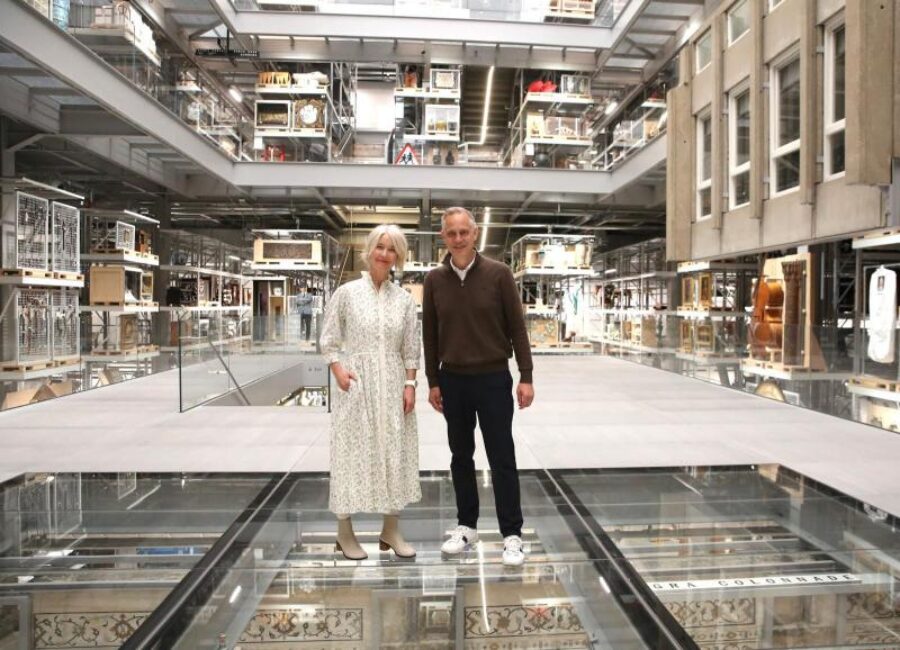On Saturday, May 31, 2025, the Victoria and Albert Museum (V&A) opened its new V&A East Storehouse in Queen Elizabeth Olympic Park. The facility is part of the new East Bank cultural quarter. The opening, which took place from 10 a.m. to 10 p.m. with free admission, is the result of a ten-year planning and consultation phase, which also involved the V&A East Youth Collective. The Storehouse is located in the former media and broadcast center of the 2012 Olympic Games.
New Concept for Museum Collections
The V&A East Storehouse is conceived as a new form of museum experience, offering access to the V&A’s collections. Spanning 16,000 square meters, it houses over 250,000 objects, 350,000 books, and 1,000 archives. Tim Reeve, Deputy Director of the V&A, stated that typically only a small portion of collections is shown to the public. The new Storehouse aims to change this and builds on the V&A’s founding mission from 1852 to make art and design accessible to a broad public.
The necessity for the Storehouse arose, among other things, from the sale of Blythe House, the V&A’s previous main depot. The new concept dispenses with traditional museum elements such as detailed labels or a strictly curated narrative and invites visitors to explore the collections independently. This type of access is intended to enable a more direct relationship with the objects.

Architecture and Design
The V&A East Storehouse was designed by the New York architectural firm Diller Scofidio + Renfro (DS+R) in collaboration with Austin-Smith:Lord. The architects transformed a part of the former Olympic media center, Here East, and deliberately incorporated its industrial character. The concept is based on an “inside-out logic,” where the center of the building is publicly accessible, while the outer areas are used for conservation, research, and depot storage.
Visitors enter the building through a functional entrance and pass through corridors lined with storage shelves into the central Weston Collections Hall. This 20-meter-high room is light-filled and traversed by steel walkways and shelving levels. Partially glazed floor panels offer views into underlying levels. “Conservation Overlooks” allow visitors to watch restorers at work. Elizabeth Diller, founding partner of DS+R, explained that the goal was to create a sense of discovery and access to normally hidden areas.
Exhibited Objects
Among the objects shown at the V&A East Storehouse are pieces that have not been publicly displayed for a long time due to their size or fragility. So-called “Large Objects” are presented in the Weston Collections Hall, including Frank Lloyd Wright’s Kaufmann Office (1935-37). This fully preserved interior is the only one of its kind outside the USA and was installed in the Storehouse after extensive restoration.
Another significant exhibit is the stage curtain for the ballet “Le Train Bleu” by the Ballets Russes from 1924, a reproduction of Pablo Picasso’s painting “Two Women Running on the Beach,” signed by the artist. The curtain, over ten meters high and eleven meters wide, is displayed in the David and Molly Lowell Borthwick Gallery, which is also designed to accommodate other monumental textiles such as Natalia Goncharova’s stage design for “The Firebird.”
Other exhibits include a carved and gilded wooden ceiling from the 15th century from the former Torrijos Palace in Spain, fragments of the demolished London social housing estate Robin Hood Gardens, the 17th-century Agra Colonnade from India, and a Frankfurt Kitchen from the 1920s. Over 100 “mini-displays” in the shelving systems show a variety of objects, including ancient Egyptian shoes, costumes by Leigh Bowery, and fashion by Issey Miyake.

“Order an Object” Service
A central element of the new access concept is the “Order an Object” service. This allows visitors to select up to five objects from the online catalog free of charge and book them for a personal viewing. Since bookings started on May 13, over 250 appointments have been made to view more than 1,000 objects. Requested objects include a 1954 silk taffeta evening dress by Cristóbal Balenciaga, 14th-century ceramics, and 1930s wedding dresses.
During the appointments, staff from the “Collection Access Team” are available to support and guide visitors. Kate Parsons, Director of Conservation, Collections Care and Access at the V&A, emphasized that this service aims to reach a new audience. Additionally, daily “Object Encounters” are offered, where staff and external experts present selected objects.
Part of the East Bank Cultural Quarter
The V&A East Storehouse is part of East Bank, a new cultural and educational quarter in Queen Elizabeth Olympic Park. With an investment sum of £1.1 billion, East Bank is a significant cultural investment project in London. Other institutions in the East Bank include Sadler’s Wells East, BBC Music Studios, UCL East (University College London), and the London College of Fashion of the University of the Arts London.
East Bank is intended to enhance East London, attract 1.5 million visitors annually, generate an economic impetus of £1.5 billion, and create jobs. The V&A already has a connection to East London through the Young V&A in Bethnal Green. The concentration of cultural and educational institutions aims to foster synergies and a creative ecosystem.

Statements on the Project
Tim Reeve, Deputy Director and COO of the V&A, described the Storehouse as a “completely new cultural experience and backstage pass to the V&A.” Elizabeth Diller of Diller Scofidio + Renfro stated that the design aims to immerse visitors in a “vast Cabinet of Curiosities.” London Mayor Sadiq Khan praised the Storehouse as a “groundbreaking museum experience.”
Kate Parsons of the V&A emphasized the democratic claim of the “Order an Object” service. Georgina Haseldine, senior curator of the V&A East Storehouse, added that visitors could learn how a museum works “behind the scenes.” V&A Director Tristram Hunt highlighted the investment in young people in East London and the support for the local creative economy. Culture Minister Sir Chris Bryant lauded the V&A’s innovative strength.
Social Aspects and Debates
The opening of the V&A East Storehouse is accompanied by discussions about social impacts. Positive aspects include the democratization of access to cultural heritage, cooperative projects with the local population, especially young people, and the creation of jobs, 75% of which are intended for local residents. Accessibility measures underscore the inclusive claim.
Critics raise concerns about the gentrification of East London in connection with the East Bank. The presentation of objects with colonial provenance, such as the Agra Colonnade, could intensify debates about restitution. The exhibition of a fragment of the demolished social housing estate Robin Hood Gardens was criticized by some as “art-washing.” Tristram Hunt defended this as part of the museum’s task to preserve uncomfortable aspects of design and social history.

Future Developments
The V&A East Storehouse is the first part of V&A East. In spring 2026, the V&A East Museum, designed by O’Donnell + Tuomey, is scheduled to open. This museum will focus on making, creativity, and global manufacturing processes. On September 13, 2025, the David Bowie Centre for the Study of Performing Arts will open within the Storehouse, making the artist’s archive accessible.
The Storehouse model could influence museum practice worldwide by offering an alternative to traditional depot storage. Parallels exist with the Depot Boijmans Van Beuningen in Rotterdam. These developments are part of the V&A’s “FuturePlan,” a program to transform the museum network. Strategic goals include expanding the audience, revolutionizing collection access, promoting creative skills, and developing into a more sustainable and inclusive organization. The V&A is committed to an anti-racist culture and addressing colonial legacies.









